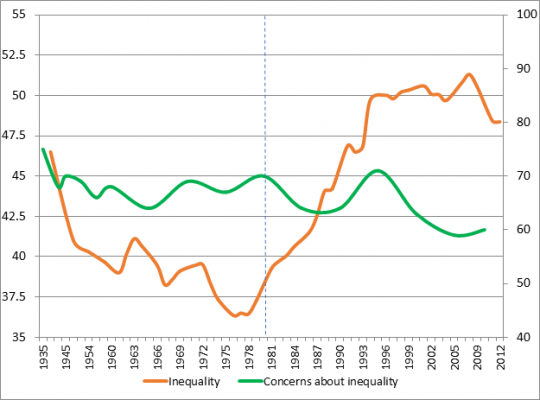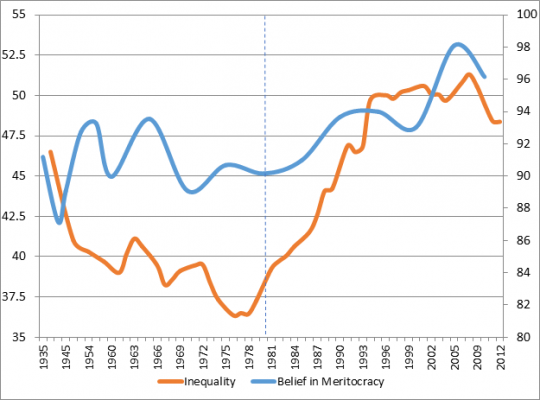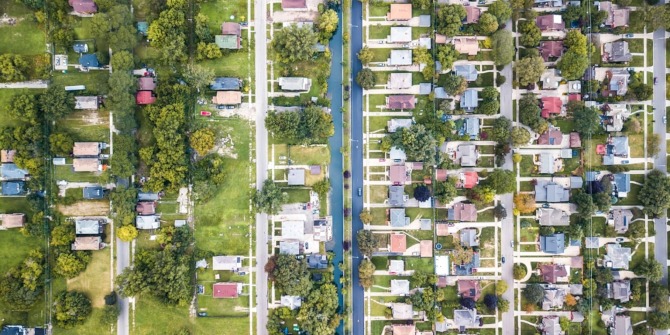 Income inequality is on the rise, a fact which many academics and commentators suggest is an important part of the election of populist figures like Donald Trump. And yet, studies show that people are actually becoming less concerned about inequality as it increases. In new research, Jonathan Mijs describes how inequality has reshaped the social landscape and how, as a result, many people are unaware of inequality’s true extent and believe that society is meritocratic – meaning that they feel that inequality is people’s own fault for not working hard enough.
Income inequality is on the rise, a fact which many academics and commentators suggest is an important part of the election of populist figures like Donald Trump. And yet, studies show that people are actually becoming less concerned about inequality as it increases. In new research, Jonathan Mijs describes how inequality has reshaped the social landscape and how, as a result, many people are unaware of inequality’s true extent and believe that society is meritocratic – meaning that they feel that inequality is people’s own fault for not working hard enough.
Ours is a deeply unequal society. The level of income inequality today has not been seen since the Great Depression of the 1920s and 30s. In recent decades, economic growth has been captured by a small segment of society, whose fortunes have grown at a much faster pace than the rest of us; to the point where the top ten percent today takes in a third of all income and two-thirds of all wealth.
Now, this dramatic rise in inequality has not gone unnoticed. The topic has received plenty of attention in academia, in politics, and in the press. What is striking however is how, despite all the attention, people just aren’t that worried about inequality.
Let’s take a look at the record of public opinion. The orange line in Figure 1 shows the trend in income inequality in the US from the 1930s to today. I’ve marked the point, in the 1980s, where inequality really starts taking off. Now, look at the trend in popular concerns about inequality – the green line. What happened to public opinion in the 1980s? Nothing, really. If anything, inequality grows, but people are becoming less concerned.
Figure 1 – Income inequality and concerns about inequality 1935-2012

Note: Inequality scale is on left axis; concerns about inequality scale is on the right axis
In fact, if we look at some of the most unequal societies in the West, it’s striking just how little inequality is a public issue. The US embodies this phenomenon: the same public that created the Occupy Wall Street movement voted a billionaire into office in 2016. That billionaire’s first order of business? Cut taxes for the rich. Mind you: the filthy rich. It’s easy to dismiss the US as an outlier, but it’s not. Rather, the US shows the trend: across the western world, greater inequalities go together with lower levels of concern. How do we make sense of this fact?
My academic research, at Harvard and at LSE, is an attempt to solve this puzzle. By collecting new data and drawing on existing sources, I study how people perceive, experience and explain inequalities in income and wealth. I’ve learned there’s two parts to why people aren’t as worried as we may think they’d be.
The first part is that many of us are unaware of the scope of economic inequality. We all know there is inequality, but most of us underestimate its extent. In a recent survey, people were asked: how much more does a CEO make, compared to their ground level workers? They put the income ratio at about 15:1. In reality, it is closer to 90:1. In America, it’s 350:1.
Meanwhile, half a million people in the US sleep on the streets on any given night. Back in Britain, rising housing costs and stagnant wages mean that one in three children grows up in poverty. This is the reality of inequality that people don’t see.
The other part of the puzzle is a little trickier. When people hear about inequality, many are quick to point to the progress made towards gender and racial equality. Undeniably, more women work than just a few decades ago. In school, girls outperform boys in many subjects; at university too. Racial disparities persist, but it’s hard to maintain that we haven’t made any progress.
These successes, if you will, are the highly visible moments of meritocracy. They render invisible the continuing constraints of social class. They’ve bolstered the belief that economic success simply reflects hard work and effort, and that the wealthy merit their wealth because it is their hard-earned money. Turning once more to the record of public opinion, Figure Two shows an uncanny correlation between inequality and belief in meritocracy in the US. As societies grow more unequal, people become convinced that theirs is a meritocratic society. A place where success comes to those who work for it and failure is due to a lack of trying.
Figure 2 – Link between inequality and belief in meritocracy

Note: Inequality scale is on left axis; Belief in Meritocracy scale is on the right axis
What is it about unequal societies that makes us more believing in meritocracy? To understand, we need to see the social transformation that has accompanied the rise in inequality.
Inequality has come to reshape the social landscape: today, how much money you make means so much more than just a number on your bank account. Income has come to determine where you live and where your children go to school. We find friends almost exclusively in our own social circles. We date people with similar levels of education and income, and when we have children, we rarely do so with someone outside of our social class. Meanwhile, we spend our days working in a stratified labor market. It’s increasingly rare to work with others who don’t share our level of education. Those people now work at the other end of the labor market, in workplaces much different from ours.
In short, social borders have come to separate the lives of the rich and poor. To visualize the kind of borders I’m talking about, let’s take an aerial view (Figure 3). This is Detroit, Michigan: the rich live on the right, the poor on the left. Photographer Johnny Miller has documented similar unequal scenes all over the world, using drone photography. Note how the spatial distance between rich and poor isn’t necessarily very large, but the borders are marked. They’re rigid, almost impermeable. You can imagine people living their lives so separately that they’ll never meet. Unless perhaps at different ends of a hierarchy: as employer and employee; entrepreneur and consumer; philanthropist and person in need. But never as equals.
Figure 3 – Aerial view of unequal Detroit, Michigan

This distance between rich and poor distorts our worldview. The spatial and social borders that separates us, becomes a cognitive border as well: neither the rich nor poor can see the lives lived on the other side. That’s because we understand the world through the lens of our social networks. We compare ourselves to friends, colleagues and neighbors; people who share much of our educational experience and economic success. We come to take for granted the advantages or disadvantages that come with our family and the place we grew up. We praise ourselves for our success, and we internalize our failures. Simultaneously, our sympathy with those in need is limited by the sense that they perhaps just didn’t work as hard as we did.
All this has an important political implication. It means that both the rich and poor underestimate the size of the gap that separates them. Because how could they see the true extent of inequality? If we cannot look past our own social circles, we cannot see the world for what it is. And there we have our answer to the puzzle. The more unequal a society, the greater the distance between rich and poor. The greater that social distance, the less we see and care about inequality. And the more likely we will stand by as the gap continues to grow.
Now imagine another world. Call it Sweden. Call it England 1975. A world where you live, who you work with, and who your friends are is unrelated to how much money you have. Where no one has to tell you about inequality. You know people from all walks of life. You know how some had it easier than others. You’ve experienced the importance as well as the limits of hard work; how circumstance impacts our lives. That’s the source of your solidarity with others.
If we want to develop a better understanding of the world we live in, we need to cross borders. If we want to live in a more equal society, one that benefits everyone, we need to first see the unequal world for what it is. And we need to ask our government for policies that help us do that. Policies that make for more diverse schools, neighborhoods, and communities. That bring people together rather than keep them apart. So the next time you’re looking to move, enroll your child in school, or vote in elections, think about the borders in your life. And of how your choices may make them stronger, or help break them down.
Listen to the author:
Greater inequalities go together with lower levels of concern. How do we make sense of this fact?
Read @JonathanMijs's new post in @LSEUSAblog: https://t.co/dxPxSItN6D pic.twitter.com/8XZRXl6hK1
— LSE (@LSEnews) May 29, 2019
Please read our comments policy before commenting
Note: This article gives the views of the author, and not the position of USAPP– American Politics and Policy, nor of the London School of Economics.
Shortened URL for this post: http://bit.ly/2VWhbZc
About the author
 Jonathan J.B. Mijs – LSE International Inequalities Institute
Jonathan J.B. Mijs – LSE International Inequalities Institute
Jonathan J.B. Mijs is an Assistant Professorial Research Fellow at the International Inequalities Institute. This blog is based on his recent TEDx London talk.




Reshape is such a strong word, isn’t it? It’s as if inequality suddenly made an appearance on the world stage. Gee, one might think it barely entered the researcher’s analytic, or perhaps even their way of understand life itself. I enjoyed the piece, just thought the phrasing is somewhat naive — so bless you, but also do better.